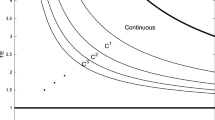Abstract
Kac’s d dimensional model gives a linear, many particle, binary collision model from which, under suitable conditions, the celebrated Boltzmann equation, in its spatially homogeneous form, arise as a mean field limit. The ergodicity of the evolution equation leads to questions about the relaxation rate, in hope that such a rate would pass on the Boltzmann equation as the number of particles goes to infinity. This program, starting with Kac and his one dimensional ‘Spectral Gap Conjecture’ at 1956, finally reached its conclusion in the Maxwellian case in a series of papers by authors such as Janvresse, Maslen, Carlen, Carvalho, Loss and Geronimo, but the hope to get a limiting relaxation rate for the Boltzmann equation with this linear method was already shown to be unrealistic (although the problem is still important and interesting due to its connection with the linearized Boltzmann operator). A less linear approach, via a many particle version of Cercignani’s conjecture, is the grounds for this paper. In our paper, we extend recent results by the author from the one dimensional Kac model to the d dimensional one, showing that the entropy-entropy production ratio, Γ N , still yields a very strong dependency in the number of particles of the problem when we consider the general case.
Similar content being viewed by others
References
Bobylev, A.V., Cercignani, C.: On the rate of entropy production for the Boltzmann equation. J. Stat. Phys. 94, 603–618 (1999)
Carlen, E.A., Carvalho, M.C., Loss, M.: Many body aspects of approach to equilibrium. In: Séminaire Equations aux Dérivées Partielles, La Chapelle sur Erdre, 2000. University of Nantes, Nantes (2000). Exp. No. XI, 12 pp
Carlen, E.A., Carvalho, M.C., Le Roux, J., Loss, M., Villani, C.: Entropy and chaos in the Kac model. Kinet. Relat. Models 3, 85–122 (2010)
Carlen, E.A., Geronimo, J.S., Loss, M.: Determination of the spectral gap in the Kac model for physical momentum and energy-conserving collisions. SIAM J. Math. Anal. 40(1), 327–364 (2008)
Carrapatoso, K.: Quantitative and qualitative Kac’s chaos on the Boltzmann sphere. arXiv:1205.1241v1
Cercignani, C.: H-Theorem and trend to equilibrium in the kinetic theory of gasses. Arch. Mech. Stosow. 34(3), 231–241 (1982). 1983
Einav, A.: On Villani’s conjecture concerning entropy production for the Kac master equation. Kinet. Relat. Models 4(2), 479–497 (2011)
Janvresse, E.: Spectral gap for Kac’s model of Boltzmann equation. Ann. Probab. 29, 288–304 (2001)
Kac, M.: Foundations of kinetic theory. In: Proceedings of the Third Berkeley Symposium on Mathematical Statistics and Probability, 1954–1955, vol. III, pp. 171–197. University of California Press, Berkeley, Los Angeles (1956)
Lanford, O.E. III: Time evolution of large classical systems. Dynamical systems, theory and applications In: Recontres, Battelle Res. Inst., Seattle, Wash., 1974, Lecture Notes in Phys., vol. 38, pp. 1–111. Springer, Berlin (1975)
Maslen, D.K.: The eigenvalues of Kac’s master equation. Math. Z. 243(2), 291–331 (2003)
McKean, H.P. Jr.: An exponential formula for solving Boltzmann’s equation for a Maxwellian gas. J. Comb. Theory 2, 358–382 (1967)
Mischlet, S., Mouhot, C.: Kac’s program in kinetic theory. arXiv:1107.3251v1
Villani, C.: A review of mathematical topics in collisional kinetic theory. In: Handbook of Mathematical Fluid Dynamics, vol. I, pp. 71–305. North-Holland, Amsterdam (2002)
Villani, C.: Cercignani’s conjecture is sometimes true and always almost true. Commun. Math. Phys. 234, 455–490 (2003)
Acknowledgements
The author would like to thank Clément Mouhot for many fruitful discussions and constant encouragement, as well as Kleber Carrapatoso for allowing him to read the preprint of his paper [5], helping to bridge the dimension gap.
Author information
Authors and Affiliations
Corresponding author
Additional information
The author was supported by ERC Grant MATKIT.
Appendix: A Fubini Type Theorem
Appendix: A Fubini Type Theorem
This appendix contains the proof to Theorem 2, which we felt would have encumbered the main article, but pose a necessary step in the proof of our main result.
Proof of Theorem 2
The proof relies heavily on the transformation (16) and the following Fubini-like formula for spheres (which can be found in [7]):
where \(d\gamma^{m}_{r}\) is the uniform probability measure on the appropriate sphere.
We start by defining the new variables

where R 1,R 2 are transformation like (16). We notice that under the above transformation the domain
transforms into
Denoting by \(\widetilde{\xi_{j}}=\sqrt{\frac{N}{N-j}} (\xi_{j}-\frac {\sqrt {j}z}{N} )\) and using the fact that R=R 1⊗R 2 is orthogonal along with (61) we find that

and since
the result follows. □
Rights and permissions
About this article
Cite this article
Einav, A. A Counter Example to Cercignani’s Conjecture for the d Dimensional Kac Model. J Stat Phys 148, 1076–1103 (2012). https://doi.org/10.1007/s10955-012-0565-z
Received:
Accepted:
Published:
Issue Date:
DOI: https://doi.org/10.1007/s10955-012-0565-z



